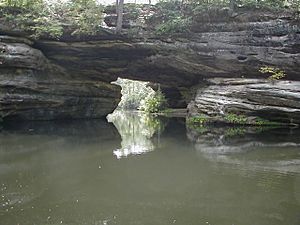Pickett CCC Memorial State Park facts for kids
Quick facts for kids Pickett Civilian Conservation Corps Memorial State Park |
|
|---|---|
| Pickett State Park | |

Arch Lake in Pickett State Park
|
|
| Lua error in Module:Location_map at line 420: attempt to index field 'wikibase' (a nil value). | |
| Type | Tennessee State Park |
| Location | Pickett County, near Jamestown, Tennessee |
| Area | 19,200 acres (78 km2) |
| Operated by | Tennessee Department of Environment and Conservation |
| Open | open year round |
| Website | Pickett CCC Memorial State Park |
|
Pickett State Rustic Park Historic District
|
|
| Built | 1934-1942 |
| Built by | Civilian Conservation Corps |
| Architect | Works Project Administration, National Park Service |
| NRHP reference No. | 86002795 |
| Added to NRHP | 1986 |
Pickett Civilian Conservation Corps Memorial State Park, often called Pickett State Park, is a special place in the Cumberland Mountains of Tennessee. It's located in Pickett County, close to Jamestown, Tennessee. This park is right next to the Big South Fork National River and Recreation Area.
The park covers about 19,200 acres (78 km2) of wild land. You can find amazing caves, natural bridges, and cool rock formations here. About 1,000 acres (4.0 km2) of this land is managed as a state park by the Tennessee Department of Environment and Conservation. The rest is a state forest, managed by the Tennessee Division of Forestry.
This park was built by the Civilian Conservation Corps (CCC). This was a group of young men who worked on public projects during the 1930s and 1940s. They worked on Pickett State Park between 1934 and 1942. The land, about 12,000 acres (49 km2), was given to Tennessee in 1933 by the Stearns Coal and Lumber Company.
The CCC crews built many things you can still see today. They made hiking trails, a main lodge, a ranger station, and five cozy cabins. They also created a 12-acre (4.9 ha) lake called Arch Lake. Most of the buildings were made using sandstone found right there in the area. These original park buildings are so important that they are listed on the National Register of Historic Places. Over the years, the park has grown with more land and new facilities.
In 2015, Pickett State Park earned a special title: a Dark Sky Park. This means it's a great spot for stargazing because there's very little light pollution from cities. The park offers lots of fun activities like boating, camping, staying in cabins, and hiking.
Contents
What Can You Do at Pickett State Park?
Pickett State Park has many facilities for visitors to enjoy. You can go camping or stay in one of the park's cabins.
Camping at Pickett State Park
The park has 32 campsites where you can set up your tent or park your RV. Each campsite has electricity and water hookups. They also come with picnic tables and grills for cooking. The campground has a modern bathhouse with showers and a dump station for RVs. It's open all year round, and you can usually find a spot without a reservation. You can stay for up to two weeks.
Cozy Cabins for Your Stay
Pickett State Park offers 20 rental cabins. There are four different types of cabins to choose from:
- The rustic CCC cabins can fit up to four people.
- Deluxe Cabins are larger and can hold up to six people.
- Chalet cabins are perfect for two people.
- Villa cabins are the biggest, fitting up to eight people.
All cabins come with modern bathrooms, kitchen appliances, and cooking tools. They also have linens, towels, and fireplaces. You can reserve most cabins up to a year in advance for any time of year. One deluxe cabin even allows pets!
Amazing Things to See at the Park
Pickett State Park is home to some unique natural attractions.
Hazard Cave and Its Glowing Worms
At Hazard Cave, you can find a special kind of glow worm. These tiny creatures were discovered here in 1975. They are actually the larvae of a fungus gnat, called Ofelia fultoni. These glow worms are rare and are only found in a few places in the United States. One other place is the nearby Big South Fork National Recreation Area.
Inside the dark areas of Hazard Cave, these glow worms create a beautiful blue light. They make the cave walls and nearby plants glow! You can see them throughout the year, but they are brightest and most amazing in early June. It's like a natural light show!

